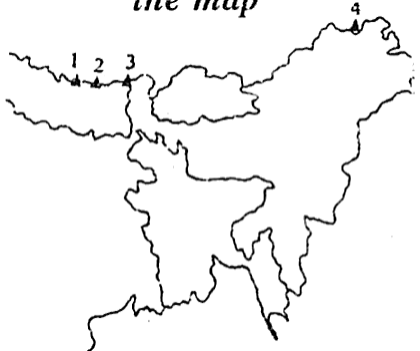 Multiple Choice Questions
Multiple Choice QuestionsThe Narmada river in the Peninsular plateau flows westward with a remarkably straight channel. It is because of the:
slope gradient in this part controls the river channel pattern.
the river carries a huge amount of water which has created a straight channel course
the river forms the boundary between the Central Highlands and the Deccan Plateau.
the river flows through the trough of a rift valley inclined westward.
No trees are found in the Tundra biome near-polar region of the northern hemisphere. This is due to:
snowfall inhibits plant respiration.
frozen ice beneath the surface soil (permafrost) restricts roots growth
less wind movement and inadequate sunlight:
low temperature which restricts development of reproductive organs
Why do the summer monsoon winds blow from the southwestern direction in the northern hemisphere?
The general direction of the wind from the Indian Ocean is south-western
The presence of the doldrums around the Equator
The low-pressure condition in north-west India
Due to the effect of Coriolis force
If the Earth's axis were perpendicular to the plane of its orbit, which one among the following would not have happened?
The North Pole will always lie in the dark
Days and nights would be equal throughout the yea
No change of seasons will take place
The sun will be perpendicular to the Equato
Match List-I with List-II
List I (Peak in the Eastern Himalaya)
List II (Location in the map)

(a) - 2, (b) - 3, (c) - 4, (d) - 1
(a) - 2, (b) - 4, (c) - 3, (d) - 1
(a) - 1, (b) - 4, (c) - 3, (d) - 2
(a) - 1, (b) - 3, (c) - 4, (d) - 2
B.
(a) - 2, (b) - 4, (c) - 3, (d) - 1
Which one among the following is the best reason for the marked increase· in agricultural production in India in the past decades?
Increase in the area under cultivation
Conversion of barren land into agricultural land
Use of improved agricultural methods and technologies
Priority status given by the successive governments to agricultural sector over the industry sector
Which of the following statements regarding the Deccan Traps is/are correct?
Select the correct answer using the code given below:
1 and 2 only
1,2 and 3
3 only
1 only
Consider the following statements
Which of the statements given above is/are correct?
1 only
2 only
Both 1 and 2
Neither 1 nor 2
Examine the statements and choose the correct alternative.
Statement I: Decay and disintegration of rocks in situ is called weathering
Statement II: Mechanical weathering is mainly caused by temperature variation
Both the statements are individually true and statement II is the correct explanation of statement I
Both the statements are individually true but statement II is not the correct explanation of statement I
Statement I is true but Statement II is false
Statement I is false but statement II is true
Examine the statements and choose the correct alternative.
Statement I: The semi-arid tracts of India stretching from eastern Rajasthan in the north to south-central Tamil Nadu are agriculturally less productive
Statement II: The semi-arid tracts are homeland to a large number of central Indian Scheduled Tribe population
Both the statements are individually true and statement II is the correct explanation of statement I
Both the statements are individually true but statement II is not the correct explanation of statement I
Statement I is true but Statement II is false
Statement I is false but statement II is true
